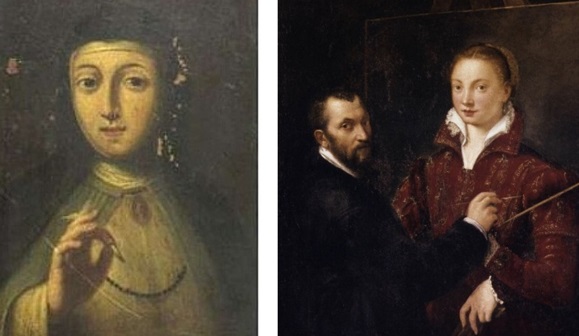‘Son of a bitch,’ possibly, but ‘Nelli,’ not on your nellie!
When we put the new roof on the 17th century part of the mill complex in the next month or so, we are going to take the opportunity to create two new stylish bedrooms for our guests at the same time. (This is where we normally sleep, so we are going to relocate to another part of the mill.)The problem is: What on earth are we going to call these bedrooms?
As you know, our policy has been to name our rooms after renowned Renaissance Italian artists and architects: Botticelli, Bronzino, Brunelleschi, Donatello, Fra Angelico, Ghiberti, Ghirlandaio, Lippi, Uccello and Vasari. At Lois’s suggestion, we also named one bedroom after that feminist icon, Artemisia Gentileschi.
We think it behoves us to add another Italian female painter. But who? Our research has come up with two names: Plautilla Nelli (1524-1588), a Florentine nun who concentrated on religious subjects, and Sofonisba Anguissola (c.1532-1625), from Cremona, who became official court painter to Philip II, the King of Spain.
Above are Plautilla’s self portrait and Sofonisba’s, Bernardino Campi Painting Sofonisba
In the interests of marital harmony, Bill is quite happy to name of the new bedrooms after a female artist, but he baulked at Plautilla Nelli: “Not on your Nellie! Nobody is going to stay a bedroom called that.”
You will have noticed that we use our artists’ surnames (we have no Leonardo [di ser Piero da Vinci], Michelangelo [di Lodovico Buonarroti Simoni] or Raphael [Raffaello [Sanzio da Urbino], who are universally known by their first names alone.) Which is just as well, When I first encountered Sofonisba’s name, I pronounced it ‘Son of a bitcha,‘ an unfortunate malapropism.
Mind you, her surname also poses difficulties with pronunciation. It is ‘an-gwi-sol-la,’ with the stress on the second syllable. Pronunciation apart, I much prefer Sofonisba’s paintings to the somewhat dreary religious creations of Plautilla, particularly the wonderful ‘The Chess Game’ (at the top of this story), which features her three younger sisters (and a housemaid). It was painted in 1555 when she was only 23. All the protagonists of dead now, of course, but the painting captures their youthful virility and keeps them alive even after more than 450 years. The personality of each of the sisters shines out, particularly the youngest.



